Mark Sisson's Blog, page 351
January 19, 2013
Minestrone-Inspired Soup with Quick Chicken Stock
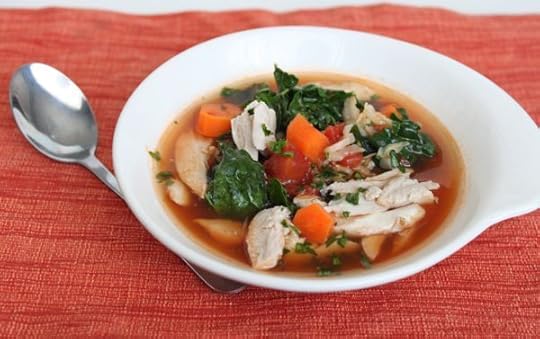 Minestrone is Italian vegetable soup, a one-pot meal that provides the perfect opportunity to clean out the fridge. This hearty version is made with homemade chicken stock (and cooked chicken) that’s ready in about 30 minutes, to which you can add any vegetables you have on hand.
Minestrone is Italian vegetable soup, a one-pot meal that provides the perfect opportunity to clean out the fridge. This hearty version is made with homemade chicken stock (and cooked chicken) that’s ready in about 30 minutes, to which you can add any vegetables you have on hand.
This chicken stock isn’t quite as nutrient rich as stock that’s simmered for hours, but it still tastes so much better than canned stock. Plus, you’ll have enough cooked chicken for the soup and another meal.
Minestrone is delicious with only the carrots, cabbage and kale this recipe calls for, but don’t hesitate to throw in other veggie odds and ends from the fridge. Zucchini, broccoli, root vegetables and green beans are all great additions. The more veggies you add, the less likely you are to miss the beans, pasta or rice that usually bulk up a bowl of minestrone.
Serves: 8
Time in the Kitchen: 1 hour 45 minutes
Ingredients:
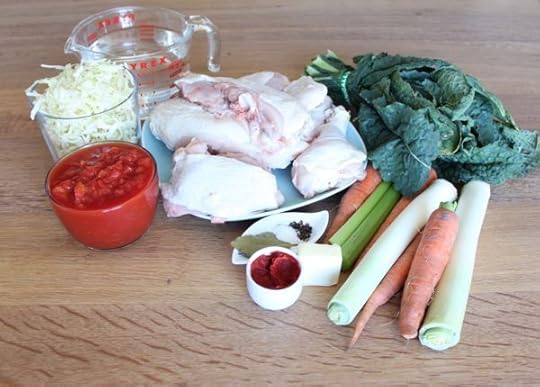
4 tablespoons butter or olive oil (60 g/ml)
1 whole chicken, approximately 3 pounds, cut into pieces (1.5 kg)
2 leeks, thinly sliced
2 celery ribs, chopped
8 cups of water (1.9 L)
1 1/2 teaspoons salt (7 ml)
2 bay leaves
1/2 teaspoon black peppercorns (2 ml)
2 tablespoons tomato paste (30 ml)
2 cups crushed tomatoes (500 ml)
4 carrots, chopped
1/4 to 1/2 of a green cabbage, thinly sliced
1 small bunch of kale, leaves thinly sliced (tough stems and middle rib removed)
Plus, a few more cups of any other chopped veggies you have on hand
Instructions:
In a deep pot, heat 2 tablespoons of the butter/oil over medium-high heat.
Place 4 to 6 pieces of chicken in the pot, or as many pieces as you can fit in one layer. Brown the pieces of chicken on both sides. As the chicken browns, remove it from the pot and add new pieces until all the chicken is browned. Set aside.
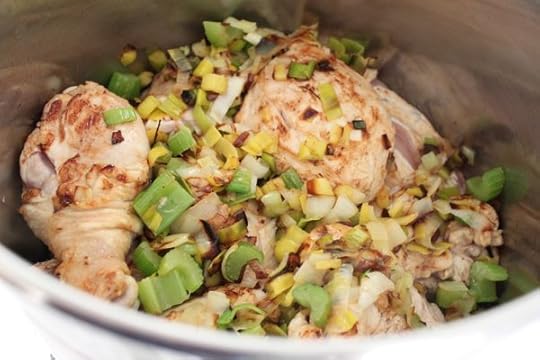
Heat one more tablespoon of butter/oil in the pot then add the leeks and celery. Sauté a few minutes until they begin to soften.
Add the water, salt, bay leaves and peppercorns.
Bring the water to a boil and skim the foam off the top. Reduce the heat so the water is at a simmer.
Partially cover the pot. Simmer for 30 minutes. (Note: if you like, you can remove the chicken breasts sooner than 30 minutes, so they don’t overcook)
Pour the soup through a colander that is setting over a large bowl or pot. The chicken and other solids will be caught in the colander and the broth will be saved in the bowl below.
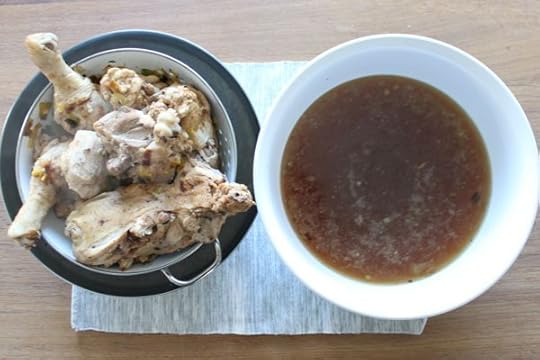
Wash out the original soup pot. Over medium heat, add the remaining tablespoon of butter to the soup pot and the tomato paste. Stir the paste as it browns for one minute, then add the tomatoes. Simmer the tomatoes for 7 to 10 minutes, stirring occasionally, to thicken.
Pour the reserved broth into the pot with the tomatoes. Bring to a simmer then add the carrots, cabbage and any other firm vegetables you want to add.
Simmer uncovered for at least 10 minutes, or until carrots and other vegetables have reached desired doneness.
While the carrots and cabbage simmer, take the chicken meat of the bones. Slice up as much chicken as you would like to add to the soup. Save the rest for another meal.
Add the kale and chicken to the soup pot. Simmer just a few minutes, to wilt kale and warm chicken.
Add sea salt and black pepper to taste.
Recipe Note: If you’d like to freeze half of the soup, consider freezing the tomato-flavored broth and chicken, without any vegetables. Add fresh vegetables after defrosting and heating up the soup, for better texture and flavor.

Get All Three Primal Cookbooks, an Apron and More in The Primal Blueprint Chef Kit Today!

January 18, 2013
I Just Had to Find the Right Path
It’s Friday, everyone! And that means another Primal Blueprint Real Life Story from a Mark’s Daily Apple reader. If you have your own success story and would like to share it with me and the Mark’s Daily Apple community please contact me here. I’ll continue to publish these each Friday as long as they keep coming in. Thank you for reading!
 Dear Mark,
Dear Mark,
My story is not one of significant weight loss or dramatic health changes, but one of mental freedom and peace that I have not felt in over 20 years. You have changed my life and I am enormously grateful to you. I have been struggling with my weight and my mental status surrounding my weight for 20 years. I am 5 feet 6 inches and during college I weighed as much as 145 lbs. But for most of the past 20 years I have weighed around 128 lbs. I fully recognize that this was not overweight and is quite healthy, but I also knew that I was religious about what I ate and exercised a ton. My body did not reflect my hard work.
Based on what conventional wisdom was telling me, I should have been quite content with the number of calories I was consuming. In actuality, I was STARVING all the time and was white knuckling my 128 pounds for years. I wanted to be the best I could be and I knew from the bottom of my heart things weren’t right. I wasn’t setting an unrealistic goal for myself, I just knew things weren’t supposed to be so hard. I just had to find the right path. My family thought I was crazy, but I was relentless and kept trying to find the answers I knew I wasn’t getting. And so my journey began…
About 10 years ago, I did the Atkins diet and successfully got down to 123 lbs. I stayed there for a good 5-6 years. During that time, I had a baby and lost the weight fairly easily. Unfortunately, while I was on the Atkins diet, my focus was on low carb, not necessarily healthy whole food. Goodness knows what kind of chemicals I had been putting into my body.
I also started running about the same time I tried Atkins. I had always been very active, but not a very good runner. I wanted to be a runner. I ran a 10k, then a half marathon and then a marathon. I was finally a runner. I started running as a means to burn calories, but thankfully, I also found that I truly enjoyed that time to myself and the feeling it gave me. It was the only time I appreciated my body. I qualified for Boston, ran Boston, had another son and kept on running.
I had a really hard time losing the weight after I had my second son. I was stuck at 128 lbs, not a big deal, but also not where I knew I could go. I had gotten away from the strict Atkins diet because I had a family to think about. My focus had shifted from wanting to look good on the outside to wanting to do the right thing on the inside. I thought this meant whole grains, low fat and very little meat. I was still STARVING all the time.
After the birth of my second son, I immediately started training for my 6th marathon. I was running 60 miles a week just a few short months after he was born. Not surprisingly, I ran a horrible marathon and I still couldn’t lose those last 5 lbs. I needed a break from running, so two years ago I decided to do a Half Ironman. If I just burn more calories, I will lose the weight, right? During my HIM training, I participated in an online training group and met a lot of great women through that venue. I couldn’t believe how many women said they gained weight while training. How could this be? Few people are as fastidious about what they eat and their training as these triathletes. I began to think what if everything we have been reading/being told isn’t right. What if all these carbs (read processed food) aren’t the answer?
I loved the HIM experience and am glad this journey has taken me down these athletic paths, but I was mentally unsettled. I was always anxious about my weight and hungry all the time. I knew the more I exercised, the hungrier I got, but I couldn’t stop for fear of gaining weight. Plus, I found myself in a unique situation in which I genuinely liked the exercise and didn’t want to stop. I would spend all day trying to fight the hunger and was miserable. I kept reading articles that told me to continue down this path, but this time just work a little harder and so I did, only to end up in the same place once again.
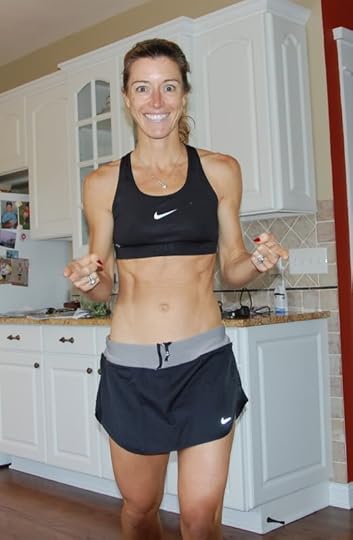
About 8 months ago, I stumbled upon Mark’s Daily Apple and it has totally changed my life. I have increased my fat and protein and dramatically reduced my carb intake. Although this is similar to the Atkins diet, this time, I am eating all organic, grass fed, REAL FOOD and I feel amazing. No processed food and very little sugar. I feel good about feeding this to my family and raising my kids with this lifestyle in mind.
I just ran the Chicago Marathon and I can’t believe how great I felt during my training runs with so few carbs. Much to my surprise, I didn’t have to eat anything on my runs. During previous training, I would eat a bagel with honey before my run and at least 1 or 2 gels during my run plus Gatorade. I still can’t believe how I have been able to convert my body from burning sugar to fat. On race morning, I ate a very light breakfast and only drank water during the race. I never bonked and even managed negative splits.
I ran my third fastest time, but trained less than I ever had before. I am trying to incorporate the exercise principals into my life as well as the eating. I do feel blessed for all that running has given me but now I feel a sense of freedom about the need to run high mileage. I have found the answer to controlling my weight and more importantly my hunger. Thankfully it does not involve running 60 miles a week or restricting myself. I am not sure where my running will take me in the future but I know that the motivation will be from the pure enjoyment of getting outside every morning (even in January in WI) not the calories burned.
I am back down to 121 lbs, but the best part of eating this way is the mental freedom and the sense of calm it has given me. I am no longer obsessively thinking about food during all my waking hours. I used to make it until 4:00 in the afternoon and then I could barely stand it anymore because I was so hungry. This would inevitably make me feel badly about myself because I couldn’t keep my hunger at bay. Going through life hungry and feeling badly about oneself is no way to live.
I knew that conventional wisdom wasn’t working for me. I spent 20 years beating my head against the wall and then finally stumbled upon a few amazing web sites and my life has changed forever. It is crazy to think that I spent all those years stressing over food and couldn’t lose any weight. Now I don’t think about it much at all and I weigh less than I have since high school.
Admittedly my before and after pictures won’t impress anyone, so I didn’t include any before pictures. I wasn’t really overweight before, but that wasn’t the point of my journey. I don’t look much different on the outside, but if you could see a picture of the before and after on the inside, it would be dramatic.
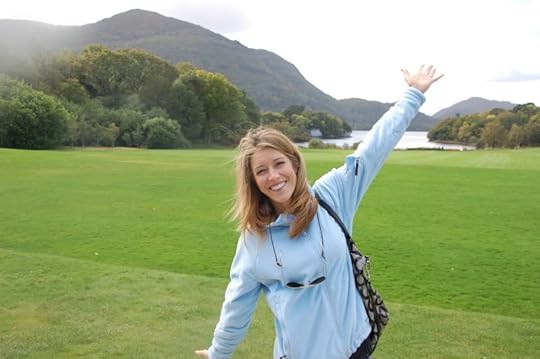
Thank you Mark!
Keri
Grab a Copy of The Primal Connection and Take Control of Your Life Today!

January 17, 2013
Co-Sleeping: The Risks and the Benefits
 Co-sleeping, bed sharing, or whatever else you want to call it – is an abomination of a behavior that no self-respecting mammal engages in. If you don’t believe me, consider how other mammals handle their kids. You know the old can and string phones we used to make as kids? New chimpanzee parents will string a vine between two empty coconut shell halves, placing one half in the baby chimp’s nest in the next tree over and the other half in the parents’ nest, allowing them to monitor the baby’s cries and activity during the night. If the baby wakes up, they’ll swing on over to the other tree and produce a hairy teat until the little chimp quiets down. Then it’s back to bed. The first thing female voles do after giving birth is dig a separate hole in the ground where the infants will sleep. Same with gophers. Kangaroos are famous for their pouches, which for years researchers assumed the mothers used to keep their infants safe, with easy access to the nipples. But in actuality, the kangaroo pouch is used to store shrubs, grasses, various other edible plants, and boxing gloves, as well as cover up their breasts (kangaroos are incredibly shy and modest creatures).
Co-sleeping, bed sharing, or whatever else you want to call it – is an abomination of a behavior that no self-respecting mammal engages in. If you don’t believe me, consider how other mammals handle their kids. You know the old can and string phones we used to make as kids? New chimpanzee parents will string a vine between two empty coconut shell halves, placing one half in the baby chimp’s nest in the next tree over and the other half in the parents’ nest, allowing them to monitor the baby’s cries and activity during the night. If the baby wakes up, they’ll swing on over to the other tree and produce a hairy teat until the little chimp quiets down. Then it’s back to bed. The first thing female voles do after giving birth is dig a separate hole in the ground where the infants will sleep. Same with gophers. Kangaroos are famous for their pouches, which for years researchers assumed the mothers used to keep their infants safe, with easy access to the nipples. But in actuality, the kangaroo pouch is used to store shrubs, grasses, various other edible plants, and boxing gloves, as well as cover up their breasts (kangaroos are incredibly shy and modest creatures).
That’s all nonsense, of course, in case you couldn’t tell already. Mammals are huge co-sleepers and bed-sharers. Heck, they exclusively breastfeed, avoid epidurals, give birth at home, and, in the case of marine mammals, are totally into the whole water birth thing. And, from what I understand, the North American deer population is solely responsible for the petition to bring Mothering back to print form (their hooves preclude them from typing, or else they’d totally read the online version). You might say that mammals are the hippies of the animal kingdom. But wait – we’re mammals, too. Doesn’t it make sense for us to share beds with our young children, or maybe share bedrooms? At the very least, shouldn’t we explore the possibility that sleeping with our infants – a behavior that many new parents are drawn toward – is safe and maybe even beneficial?
I’m going to level with you guys before I write anything more: I’m a big proponent of co-sleeping. Carrie and I did it with our kids, and I’m convinced it was the right move. It brought us closer to our kids and to each other. It helped us sleep, when sleep was a hot commodity. I certainly understand why some folks are hesitant to promote or attempt it, but I’m pretty biased in favor of co-sleeping for obvious reasons (it just seems to work).
I gave this topic a brief mention in Monday’s post, and the reader response made me feel like writing a more comprehensive series of posts on the subject was in order. So let’s look at the possible risks and benefits.
Is co-sleeping safe?
First, let’s define co-sleeping. Co-sleeping can refer to three different practices:
Room-sharing, where the baby sleeps in the same room as the parents but in a separate bed/crib.
Bed-sharing, where the baby sleeps in the same bed as the parents.
Couch-sharing, where the baby sleeps with the parent(s) on the couch or sofa.
Are there risks associated with the various types of co-sleeping? Somewhat.
Room-sharing is strongly associated with a reduced risk of sudden infant death syndrome (SIDS), and the American Academy of Pediatrics actually recommends that parents room-share early on. That’s a great start!
Couch-sharing is inherently dangerous, due to the increased chance of the baby falling between the cushions and being pushed up against the back to suffocate.
Bed-sharing is the controversial one. It can be dangerous, if certain precautions aren’t taken, but it also appears to have a host of benefits if done the right way (which I’ll discuss below). Unfortunately, little distinction is made between couch-sharing and bed-sharing when people talk about co-sleeping – even though the two are worlds apart. Even the purported links between bed-sharing and increased danger to the babies are tenuous and confounded by other variables, like drug and alcohol usage, smoking, and poverty. One study, in fact, found that when you control for maternal tobacco usage, the risk vanishes altogether, while a more recent meta-analysis concluded that “there may be an association between bed-sharing and sudden infant death syndrome (SIDS) among smokers (however defined), but the evidence is not as consistent among nonsmokers.” And other studies have found that “non-elective” bed-sharing, where parents (often impoverished single mothers) co-sleep because of circumstance (crib too expensive, tiny apartment, etc.) rather than choice, is a risk for infant death (PDF). But can the results of co-sleeping as it’s often practiced in impoverished, at-risk households where cribs are a luxury and education about safe bed-sharing is nonexistent serve as indictments of co-sleeping in general?
The fact remains that bed-sharing is the evolutionary norm for mammals, including humans. That can’t be argued. According to James McKenna, perhaps the most prolific co-sleeping researcher, “There exist no ethnographic examples outside of Western, industrialized countries of infants sleeping outside the mother’s room—away from her company.” (PDF) If anything, solitary sleeping is the global and historical aberration. Indeed, in many countries and regions where bed-sharing is prevalent and culturally ingrained, like Sweden, Japan, Hong Kong, and Beijing, SIDS rates are low.
If bed-sharing were always a dangerous behavior, I have to think the instinct to do so would have been weeded out and eradicated from most traditions, rather than solidified as a cultural mainstay. After all, killing the young is unequivocally bad for the fitness of a species.
Is co-sleeping worth any potential risks?
Well, let’s look at the benefits.
Co-sleeping makes breastfeeding easier. By now, we all know how hugely beneficial breastfeeding is to a child’s development and health. Breastmilk confers immunological benefits, transfers commensal gut bacteria, and promotes bonding and closeness between mother and child. It’s nutritious (especially if the mother’s diet is nutritious), and it’s the only food everyone agrees we’re designed to consume. Further, breastfeeding is strongly and consistently associated with a lack of SIDS, a link far more consistent than the unclear link between certain types of co-sleeping and SIDS. All signs point to breastfeeding being a good move for both mother and child, so we should promote behaviors that make it easier to do. Across multiple populations and countries, including Sweden, Malaysia, and Brazil, bed-sharing is consistently associated with higher rates of breastfeeding. It may be that women who breastfeed are more likely to co-sleep, but it’s pretty obvious that not having to get up and walk to another room to feed will make breastfeeding easier.
Co-sleeping, particularly bed-sharing, helps mother and child grow attuned to each other’s sleep and awakening patterns. In one study, researchers ran sleep studies on 20 habitual co-sleeping pairs and 15 habitual solitary sleeping pairs. The co-sleepers woke more frequently, but their awakenings tended to overlap (co-sleeping moms and babies woke up at the same time) and the total nocturnal wakefulness was not increased due to decreased duration of awakenings (co-sleeping moms and babies got back to sleep faster). This allowed co-sleeping moms to respond to their children’s cries more quickly and accurately, thereby enhancing their ability to monitor the status of their children and, the researchers suggest, improving their capacity for caregiving.
Co-sleeping improves sleep. Sure, as mentioned above, you might wake up more frequently, but each awakening is far less disruptive since you don’t have to stumble over to an entirely different room in the dark. You slip right back to sleep. Most successful co-sleepers cite “improved sleep” as an important factor in their decision to do it. One study even found that breastfeeding combined with bed-sharing allowed both mother and infant to get more sleep. Some researchers theorize that these “lighter” sleep periods are even protective against SIDS in their own right.
Co-sleeping modifies the parental response to night wakings. One study found that while co-sleepers saw night wakings as normal and nothing to freak out about, parents of solitary sleepers found night wakings to be highly disruptive. If a stressor doesn’t actually register as a stressor, is it stressful? Probably not.
Co-sleeping normalizes the stress response in children. For infants, cortisol regulation in response to physical stress should be “moderate,” rather than heightened. Babies who are solitary sleepers show greater sensitivity to mild stressors, like a bathing session. In response to a stressor, one study showed that the solitary sleepers secreted more cortisol than normal, while the co-slept child secreted the “right” amount. Another study found that co-sleeping had a positive effect on babies’ cortisol regulation at 12 months. Despite “common sense” claims that co-sleeping babies will become more dependent and unable to deal with stressors, the opposite appears to be true.
Co-sleeping facilitates the bond between parent and child. Skin-to-skin contact promotes the release of oxytocin, a powerful hormone and neurotransmitter that solidifies and strengthens the bond between people.
Co-sleeping may result in better-adjusted, more independent children and adults. While you might think that co-sleeping children grow up to be dependent and helpless, most research suggests this is not the case. Some studies even show that children who co-slept as infants grow up to be more self reliant and independent. Others suggest that co-sleeping reduces tantrums, produces less “fearful” children, boosts self-esteem later in life, and helps both males and females become comfortable with intimacy as adults (among many other possible psychological benefits). At the very least, co-sleeping doesn’t create needy, dependent kids.
Next week, I’ll explain how to co-sleep the right, safe way. I’ll also tell you what not to do, along with a few alternatives to bed-sharing. Until then, do what feels right. If you’re intellectually convinced of the benefits of co-sleeping but can’t quite shake the feeling that you’re going to smother your child, don’t co-sleep. It should be a natural behavior that reduces stress, not a cortisol-laden one.
Thanks for reading folks! Be sure to leave your thoughts in the comment section; be civil. This can be a testy subject.
Get the Primal Blueprint Fitness eBook, Free Health Tips and Primal Recipes Delivered to Your Inbox

January 16, 2013
16 Things You Should Have Never Stopped Doing
 As children, we live closer to our instincts. Yes, there’s the humorous and rather unfortunate side to this – like the time you ate an entire bag of Twizzlers and threw up all over your great-aunt’s carpet. In addition to the plethora of bad decisions (as if adults don’t make those too), however, there’s the extravagant daring and that amazing, irrepressible exuberance.
As children, we live closer to our instincts. Yes, there’s the humorous and rather unfortunate side to this – like the time you ate an entire bag of Twizzlers and threw up all over your great-aunt’s carpet. In addition to the plethora of bad decisions (as if adults don’t make those too), however, there’s the extravagant daring and that amazing, irrepressible exuberance.
As adults, we might know better than to gorge on dye #40, but we’re tripped up by other things. We become distanced, detached from our instincts. The responsibilities, the schedule, the expectations surrounding our culture’s take on maturity can cast us out of the land of exuberance. It’s like we get gradually diverted to a boring Interstate stretch after traveling the scenic route. The road is efficient, utilitarian and might have nicer rest stops, but it often feels like a major letdown. What does it take to find our way back to the panoramas? What are the things we never should’ve stopped doing in the first place? I hope you add your own to the list. Let me throw out a few I’ve been thinking of today.
Climb – anything.
In addition to the workout, there’s something about the vantage point of height. Sitting in a tree, for example, you see the world and your problems differently for a short time. Once you’re on solid ground again, reality settles back in, but you’re different for having lived that time in a novel perspective. Find a favorite tree, a place you can sit on your roof, or build yourself a treehouse. Yes, it’s for you. Why not?
Jump in puddles (or snow mounds).
We adults get too fussy about weather. Our idea of inclement weather increasingly expands until we talk ourselves out of enjoying the vast majority of days. Invest in some real rain gear like you had when you were young (or just write off the need to stay dry altogether). Get out there and relish the bad weather like the amusement park it used to seem like. The novelty only wore off when we lost our imagination to make it so.
Play in the sand, dirt, mud, creek, lake, etc.
In other words, make a disgusting mess of yourself. Indulge/immerse for the all-important microbes, the sensory feast, and the subversive act of it. (It’s the ultimate snub to society’s confines.) Why do we take such pride, for example, in driving around a mud encrusted SUV? The real adventure is getting yourself caked in muck.
Eat food right off the plant/out of the dirt.
Speaking of soil… If children today even demonstrate so much as a musing to pick an apple off a tree, five parents rush over panicked yelling “Let me wash that for you!” Those of you who grew up in the 70s or earlier were probably running the neighborhood and your parents had no idea what you were up to. Left to their own devices, you probably ate any number of produce items pulled directly from the bushes, trees, and dirt (as well as worms, bugs, and other dare worthy items). You were meant to eat your fair share of dirt then. Take the chance to enjoy the same Primal goodies now.
Tell the truth.
Yeah, kids will give away the farm in any conversation while the parents bury their heads in mortification. It’s in kids’ natures to put it all out there, of course. They don’t mean any harm. As we get older, we become more tactful, we tell ourselves, more discreet and sensible, but I think there’s something we tend to give up in the process. Maybe we bury our own feelings too much. Maybe we don’t speak out against what our conscience tells us because we’re afraid of offending others, not fitting in, rocking the boat. While I don’t think anyone should give up on basic respect and reasonable limits, there’s a certain freedom in letting our emotions and true selves rise closer to the surface as they did when we were kids.
Let go of grudges.
As Crista noted in the comment section of last week’s 10 Habits of Highly Successful Hunter-Gatherers, kids are the perfect example when it comes to fix it and forget it. Forgive and move on. There’s just not enough time for bitterness when you know Mom is going to call you for dinner in two more hours. Why give up the chance for fun and risk missing out on anything good?
Test limits.
Remember pedaling as furiously as you could just to see how fast your inner superhero could go? How about jumping again and again to get higher and higher, to reach this branch and then that one. Childhood was like a never ending quest to see how brave we were. Why did we ever let go of that instinct or at least confine it into the tiny space of a career function or other “acceptable” trial? We’re clearly missing out. So go ahead. Throw a tennis ball at the wall of your house and see how many hundred times you can catch it. Run as fast as you can just for the sheer amusement of it. See how many Big Wheels you can jump over. Trust me, it’s just as important as what you had planned for the day.
Daydream.
Remember staring at the trees or just out the window for long stretches as a kid? We thought big thoughts or maybe just examined the pattern of scratches on the sill. We’d do well to give ourselves the same mental leisure once in a while. Not only is it relaxing, it can morph into its own flow state when we can be at our most creative.
Move spontaneously.
The daughter of a friend of ours is the perfect example. At six years old, she’s still in that “living fabulous” phase (which every parent hopes will never end). She sings at frequent and random parts of the day. She runs and leaps and dances at whim whether she’s in a grocery store, on the beach, at school, or at home. How do we lose that? Remember the days before self-consciousness set in? When did we stop doing what feels good in the moment? Even if you can’t bring yourself to dance at your work station (although I’ve known plenty of fun people who do), let loose at home and consider trying some Parkour, Zumba, or other way to get you moving differently for your workouts. It’s a start.
Go to bed early.
Sure, we all whined and belly ached about it, but in ten minutes we were out like lights. Play hard, sleep hard. The early turn-in did more than give our parents some peace and quiet. There’s truth to the adage, an hour before midnight is worth two after. It has to do with our circadian rhythms and the pattern of deeper sleep. We stay up late to carve out more personal time or to get more done, but we’d be better off hitting the sack early and dialing back the alarm clock by an hour or two. No one loves getting up early, but we’d be better rested throughout the day as a result. We’d also enjoy a lot less stressful and more productive beginning to the day.
Laugh early and often throughout the day.
Spend a day around young kids, and you’ll lose count of how many times they yuck it up in a day. They’ll laugh for minutes on end at the simplest, even most inane things. And I’m not talking one of the polite chuckles we adults often grant each other in conversation. The old “Chicken butt” joke alone elicits round upon round of riotous belly laughs. Sure, we might need more incentive than the average four-year-old, but why don’t we prioritize laughter more? There are the laughter yoga groups, yes, but how many hilarious books, stand-up, and movies are out there? Who are the friends and acquaintances with the personalities and stories to keep you laughing for hours? Your cardiovascular system needs these folks. It flourishes with the entertainment.
Read.
How many of us stayed up late with flash lights under the covers to read our favorite books? (Okay, so we didn’t always get to sleep right away.) It was easy to get swept up then in imagining other worlds. Maybe it was because we’d likely seen so little of the world at that point. Picking up a good book today can be a therapeutic escape from the day or a reminder to get out and make more of life.
Play games.
Somehow kickball never got old as a kid. Neither did Frisbee or ping pong or just about any other game. The movement, the challenge, the competition, the humor, the adrenaline of it all kept our enthusiasm running at full speed for hours. As an adult these days, a whole game can seem like such a commitment. We guard our time “responsibly” but too often go and blow it on the Internet (present blog excluded) or other media. Sometimes we even seem to sit uncomfortably with it, unwilling to commit to a real activity because we’re waiting for the other shoe to drop and another chore to appear. Free time should be quality time. Take a leap of faith and commit to a board game. Even better, find out how much more fun tug-of-war is in the snow. Play some hockey on the ice at the corner park, or do relays in the backyard with the kids.
Create.
We were at a cabin a few months ago with a larger group. One friend is an art teacher and kept the kids absolutely enthralled by building small houses with all the wood, rocks, flowers, and leaves they could find. The result – and his enthusiastic example – were impressive. Unless we’re in a creative profession, we tend to give that side of ourselves short shrift as adults. Exercising our creativity can help us hone our identities as we get older and celebrate new stages of our lives. Other times it just feels good.
Skip meals (when there’s something more exciting to be enjoyed).
Remember how crushed you were when it was time to come in for lunch/dinner/errands/school/etc. when you and your friends were just getting to the best part of your play? You were on the very edge of a full-blown revelation, the cusp of some great and grandiose scheme that was sure to propel you all toward some amazing success. You know the benefits of intermittent fasting, but it doesn’t have to be the formal, preplanned routine we often make it. If you keep life busy and spontaneous enough, you just might find plenty of opportunity to fit in fasting without ever thinking about it.
Stay outside until the last possible minute.
Why do we impose such early curfews on ourselves? Didn’t we all swear up and down that when we grew up we’d stay out as long as wanted (foot stomp added for emotional emphasis)? Imagine what would be possible if we opened up several more hours to relish the outdoors? Sure, we might miss the benefits of the sun, but the evening and night offers their own rhythms we can enjoy. They inspire different moods, different activities, different adventures. Why limit our outdoor lives?
Next one – your turn. What are the things you think we should’ve never stopped doing? Thanks for reading today, everybody. Share the stuff you refuse to outgrow, and have a great weekend.
Get Your Copy of The Primal Connection: Follow Your Genetic Blueprint to Health and Happiness Today!

January 15, 2013
Is it Primal? – Balsamic Vinegar, Chestnuts, Apricot Kernels, and Other Foods Scrutinized
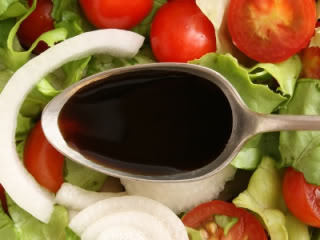 It’s time for yet another edition of “Is It Primal?” where I determine and decree the worthiness of various foods. First up, I discuss balsamic vinegar – both types – and explain whether or not it belongs in a Primal eating plan. After that, chestnuts get roasted over the open fire of my analysis. Apricot kernels, those weird little almond lookalikes, are next, followed by chitosan. Finally, I cover the safety and healthfulness of Korean nori snacks. Keep in mind, readers: once my edict on a particular food has been handed down, once it has been deemed Primal or not Primal, the word is sacrosanct. It must be hewed to, or else you will suffer the consequences, which can include such horrors as revocation of your Primal Cred card or banishment to Vegan Island.
It’s time for yet another edition of “Is It Primal?” where I determine and decree the worthiness of various foods. First up, I discuss balsamic vinegar – both types – and explain whether or not it belongs in a Primal eating plan. After that, chestnuts get roasted over the open fire of my analysis. Apricot kernels, those weird little almond lookalikes, are next, followed by chitosan. Finally, I cover the safety and healthfulness of Korean nori snacks. Keep in mind, readers: once my edict on a particular food has been handed down, once it has been deemed Primal or not Primal, the word is sacrosanct. It must be hewed to, or else you will suffer the consequences, which can include such horrors as revocation of your Primal Cred card or banishment to Vegan Island.
Take heed.
Balsamic Vinegar
There are essentially two primary types of balsamic vinegar. The first, made according to traditional practices and standards, involves reducing grape juice (from grapes grown in specific regions of Italy) down to 30% of volume to form a must, followed by a 12-year fermentation of the must in a variety of wood barrels during which time the flavors and various other bioactive compounds form and develop. This stuff is expensive, going for as much as several hundred dollars a bottle. It’s called traditional balsamic vinegar, or Aceto Balsamico Tradizionale.
The second is balsamic vinegar of Modena, which is made using wine vinegar, caramel, and grape must. Basic balsamic vinegars are technically aged, but very rarely for as long as twelve years. A couple months appears to be the minimum.
Vinegar itself, regardless of the origin, lowers the blood sugar response to a meal, improves the glucose tolerance, and even increases the satiety of a meal when taken before or during the meal. Acetic acid is the key here, so rice vinegar, apple cider vinegar, red wine vinegar, and even white vinegar will work just as well as the best balsamic vinegar. But some benefits are unique to balsamic vinegar:
Balsamic vinegar inhibited LDL oxidation and macrophage accumulation to a greater extent than rice wine vinegar. In other words, balsamic vinegar – regular old stuff purchased at a Japanese supermarket - may inhibit atherosclerosis.
During simulated digestion of meat, melanoidins that arise during traditional balsamic vinegar fermentation reduced lipid peroxidation and heme iron absorption.
All this data is beginning to make that pre-dinner salad with olive oil and balsamic look pretty appetizing, eh? I imagine marinating one’s meat in a balsamic vinegar solution would also have beneficial effects on lipid oxidation.
Verdict: Primal (so long as you don’t eat it with bread!).
Chestnuts
Unlike most other nuts, chestnuts are relatively low in fat and high in starch. They’re also quite low in phytic acid, so the whole mineral absorption issue won’t affect your enjoyment of chestnuts. Chestnuts are high in carbs, so treat them more like sweet potatoes or white potatoes than almonds or macadamia nuts – as an ideal post-workout snack, perfect for replenishing depleted glycogen stores. Also, because chestnuts are, well, nuts, they offer a pleasantly nutty taste. Some folks are even making chestnut protein powder pudding. I gotta say, it looks pretty delicious.
As far as micronutrients go, chestnuts are notable for their vitamin C, copper, and manganese content. If you’re low on any of these nutrients, chestnuts may be a useful addition.
Roasted on an open fire, cracked and eaten raw off the tree, or whipped into a Neolithic protein powder slurry, chestnuts are solid choices.
Verdict: Primal.
Apricot Kernels
There was an episode of GI Joe (yes, I’ve seen a few episodes in my day) from way back where a giant blob was ravaging the countryside. Bullets weren’t stopping it and bombs were ineffective, so the Joes make one last-ditch effort to beat the thing: they bombard the blob with apples. You see, apple seeds – and all seeds from the rose family, which includes apples, plums, cherries, apricots, peaches, and almonds – contain cyanogenetic glycosides, which degrade to hydrogen cyanide upon digestion. In ample enough doses, apple seeds can kill a murderous, otherwise invincible blob. Apricot kernels are among the richest sources of cyanogenetic glycosides, and cases of acute apricot kernel poisoning have been reported. The average apricot kernel contains 0.5 mg of cyanide (PDF), and the average fatal dose for cyanide in humans is around 1.5 mg/kg bodyweight.
Of course, some people claim that certain cyanogenetic glycosides, such as amygdalin, are actually potent cancer fighters. Apricot kernels also have high ORAC values and lots of phenolic content, but they aren’t alone in that respect. Most plant food has some study or other showing high antioxidant activity. It doesn’t make the food essential or even necessarily worthwhile, particularly if it also comes with cyanide. Eat some blueberries, which are cyanide-free and have far less linoleic acid.
Avoid making apricot kernel meal baked goods. Don’t make apricot kernel meal pancakes, however much coconut butter you incorporate. If a few kernels find their way into your mouth, go ahead and chew and swallow. Just don’t make it a staple, and don’t rely on it to beat cancer.
Verdict: Not Primal (avoid poisonous things).
Chitosan
Chitosan comes from the deacetylation of chitin, the substance that makes up exoskeletons. The structural cohesion of insects, crustaceans, and even fungi depend on chitin; that’s the stuff that gets stuck in between your teeth after a meal of shrimp with the shells on (or crickets). It’s unclear whether humans fully (or even partially) digest chitin, as chitinase – the enzyme that digests chitin – isn’t found in all human gastric juice samples. Researchers have found that gastric juices from Westerners (who eat fewer insects and are exposed to fewer chitinous parasites) are less likely to have chitinase, while gastric juices from non-Westerners tend to have more chitinase. The point, though, is that people can produce chitinase that degrades chitin, and if they don’t, eating more chitin-containing foods should stimulate chitinase production.
Chitosan supplementation may reduce cartilage destruction in autoimmune arthritis.
In healthy men, pre-breakfast supplementation with 3 grams of chitosan increased fecal excretion of dioxins and PCBs, two prominent types of xenoestrogenic compounds found in most modern diets.
A chitin-glucan supplement (extracted from fungi) lowered oxidized LDL in humans. Oxidized LDL is likely causally related to atherosclerosis (as opposed to just plain ol’ LDL), so this could be a helpful supplement for people at risk.
When I’m presented with a shell-on shrimp, I do one of two things. If it’s a massive jumbo shrimp, I’ll usually remove the shell. If it’s a smaller, more manageable shrimp, I’ll eat the entire thing without blinking. The legs are my personal favorite, particularly if they’ve been crisped up in a bit of butter. So yeah, I eat a fair amount of chitosan/chitin. Our ancestors (and every other current culture that utilizes the insect kingdom for food) did too. If you don’t believe me, try removing the shells from a few hundred crickets. It’s far easier – and more nutritious – to simply eat the entire thing. Thus, I think it likely that chitosan is an ancestral soluble “fiber” source, one that we should probably incorporate. I’m not so sure we need to take chitosan tablets, but you might consider hoofing it down to the local Oaxacan restaurant for some chapulines (lime and chile crickets) every now and then, or at least nibbling the shrimp shells and legs when no one else is watching.
Verdict: Primal.
Korean Nori
I feel like I’ve been writing about seaweed a lot lately. Is it just me? Am I crazy?
Anyway, several readers have asked about Korean nori, worried about radiation, contamination, and ingredients used.
I wouldn’t worry about radiation from the Fukushima incident. If you look at a map, Fukushima is on the north east coast of Japan, while Korea lies to the west. Preliminary research indicates that ocean currents have directed any contaminated water out across the Pacific Ocean, rather than back toward the Asian mainland. SeaSnax, who sources their nori from Korean waters, recently had their products tested for radiation and heavy metals and got a clean bill of health.
The ingredients are usually okay. Avoid anything roasted in soybean or other vegetable oils, obviously, but I wouldn’t fret too much over a little sesame oil. True, sesame oil is high in fragile linoleic acid. True, linoleic acid has the tendency to oxidize. However, sesame oil is also imbued with natural antioxidants, like vitamin E, and it appears to be more resistant to thermal and light oxidation than soybean oil. The amounts used in most nori snacks are also so low that they shouldn’t cause much trouble. Just avoid products with excessive sugar and any questionable ingredients. In my experience, it’s no trouble finding a relatively pure Korean nori.
The safest bet is to get your own dry roasted nori sheets and add your own seasonings. Brush with bit of olive oil or butter, sprinkle some sea salt, pop in the oven for a few minutes, and you’ve got yourself a solid snack. Use it as a wrap, shred it for salads, or eat it as-is. Add other seasonings, like chili powder or curry powder.
The nutrition facts on the Wiki page (which draws from the USDA database) look incredible until you realize that they’re talking about 100 grams of nori. A single large sheet is about 3 grams. So, if you want to obtain (in percentages of RDA) 78% of niacin, 60% of thiamine, 194% of riboflavin, 475% of folate, 253% of vitamin C, 371% of vitamin K, 28% of calcium, 88% of iron, 85% of magnesium, 100% of phosphorus, 50% of potassium, 35% of sodium, 38% of zinc, and several thousand percent of iodine, along with 41 grams of protein, you’ll have to eat about 33 large sheets of nori. They’re still impressive, and nori is still nutritious, just not the savior you might have assumed.
Verdict: Primal.
That’s all I’ve got this time, folks. If you have any questions about any other foods, supplements, drinks, or condiments, be sure to send them along. Thanks for reading!
Get All Three Primal Cookbooks, an Apron and More in The Primal Blueprint Chef Kit Today!

January 14, 2013
Dear Mark: Seaweed Supplements, BMI and Mortality, and Sleep Versus Exercise
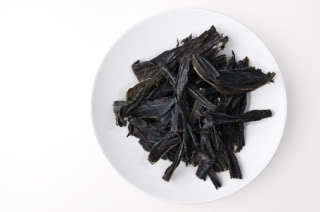 In today’s Dear Mark I discuss my favorite seaweed supplement, kelp granules, which aren’t really a supplement in the classic sense, but more of a food that you can treat as a supplement. Next, I give my thoughts on the latest study to suggest that an overweight BMI confers the lowest mortality risk in people. Finally, I handle a question from a parent currently trying to juggle sleep with exercise who wonders which to choose. It’s a tough question, to be sure, but I give my best attempt at a helpful, realistic answer.
In today’s Dear Mark I discuss my favorite seaweed supplement, kelp granules, which aren’t really a supplement in the classic sense, but more of a food that you can treat as a supplement. Next, I give my thoughts on the latest study to suggest that an overweight BMI confers the lowest mortality risk in people. Finally, I handle a question from a parent currently trying to juggle sleep with exercise who wonders which to choose. It’s a tough question, to be sure, but I give my best attempt at a helpful, realistic answer.
Let’s get to it:
Hi Mark, Is there any one special brand of seaweed supplement that you would recommend?
Thanks,
Carmen
Usually, I eat seaweed, rather than take seaweed supplements. I’m a big fan of seaweed salads from good sushi spots. They’re generally made with sesame oil, a touch of sugar, and rice vinegar, so they’re pretty Primal. I also like to drop a ribbon or two of kelp (kombu) into my bone broths an hour before I strain them. And roasted nori sheets are good as edible wrappers or roasted with a light dusting of olive oil and sea salt.
If you’re looking for brands, Maine Coast Sea Vegetables is a reputable one. They harvest their sea vegetables in the North Atlantic, regularly test their products for heavy metal contamination, and provide nutritional information for everything. I keep a few containers of their kelp granules (the seaweed highest in iodine, with a quarter teaspoon offering 20 times the RDA), and these could easily be used as a supplement. Sprinkle them on food, into water, broth, tea, or even just the palm of your hand. They lend a crunchy, briny flavor. Very tasty.
What do you think about this latest study?
CDC Researchers Find Lower Mortality Rates Among Overweight People
Should we be keeping some fat on ourselves vs getting down to less than 10% body fat OR would you say that 99% of these unhealthy thin people simply lacked the proper lean body mass and organ reserve that chubby people might have on them? I’d love you to share your thoughts with the MDA community!
Thanks,
Tim
This isn’t a new idea. For many years, studies have shown that “overweight” people (in terms of BMI) generally live longer than normal or underweight people. In fact, this latest study is a meta-analysis of all of those other studies. Here are a few thoughts:
As you guessed, part of it probably comes down to lean body mass, which BMI on its own can’t really track. In elderly Asians, BMI had no correlation to mortality risk, while more lean mass was linked to a lower risk. More lean mass means more mobility and strength, more organ reserve, and a greater ability to take care of oneself (shop for groceries, drive a car, get up out of bed, carry things, and generally be able to function day-to-day).
What about waist circumference or visceral fat versus subcutaneous fat, neither of which the meta-analysis examined? Studies that factor in waist circumference – a pretty good indicator of body fatness – show that smaller waists are healthier. In fact, a recent study that compared the utility of BMI and waist circumference in predicting mortality determined that while BMI is useful, waist circumference is more predictive. Visceral fat is also an independent predictor of mortality risk. If your BMI is higher because of squishy subcutaneous body fat, you’ll probably be healthier and die later than the guy with the same BMI because of hard intra-abdominal fat.
Illness often reduces bodyweight, too. Think about cancer, the treatments for which tend to kill appetite and reduce BMI. If you’re on the lower end of the BMI because you’re battling cancer, your mortality risk is going to be higher. Furthermore, heavier patients usually recover better from surgical procedures, like coronary bypasses. And in one study where BMIs between 22 and 26 were associated with the lowest mortality for the general population (but slightly higher for the elderly), excluding smokers and cancer patients pushed the low-mortality range “leftward” to 20. Another study showed that among men aged 65-93, those who lost weight – even if it was body fat – had a higher mortality risk. Gaining body fat was also linked to increased mortality, but the safest move was remaining weight stable.
What about morbidity – quality of life as one ages? Research indicates that those with an overweight BMI do live longer, but with a greater incidence of arthritis, diabetes, and general physical disability. Personally, I’m more concerned with improving and maintaining a high quality of life than I am with living past 100. I’d rather die younger and disease-free than older and kept alive with a plethora of medications and interventions. Live long and drop dead, I say.
There’s definitely something to having some meat on your bones. I’d hazard a guess that a mix of lean muscle and some subcutaneous fat layered on top of dense bones is the best mix for longevity and health as we age, but let’s not get carried away. All else being equal, on an individual level, being not-fat (not necessarily six pack-lean), active, fit, strong, and mobile are still the surest paths to health and happiness. This study doesn’t change that.
Dear Mark,
Thank you so much for all you do to inspire and teach so many people.
I appreciate the wisdom of the PB very much. However, lately my husband and I have been struggling to get both sufficient quality sleep AND reasonable exercise. We have a 6-month-old and a 3-year-old, and we are up at least twice and sometimes more each night. (Some people call this “nighttime parenting,” some people call it “totally sucks”…we are just trying to deal.) We both work outside the home. My husband tries to exercise in the early morning and I aim for after the kids are asleep, but both of us struggle to actually get it done, often opting for sleep instead. We do our best to make weekend family time active, but those playtimes, while fun, don’t feel sufficient. Please trust me when I say there isn’t time on weeknights between the time we get home and the time we put the kids to bed to take a significant family walk or otherwise mesh exercise with family time.
For situations where one really has to choose between sleep or exercise, which would you say is more important? Should we choose sleep 50% of the time and exercise the other 50%? Just focus on proper nutrition?
Thanks so much for any thoughts you can share.
Best,
Laura
Sleep is more important than exercise, if you have to choose. Poor sleep makes you insulin resistant, thus countering the insulin-sensitizing effect exercise normally has on muscle. Poor sleep increases oxidative stress and inflammation, essentially acting as another stressor on top of exercise. Sleep deprivation also worsens your posture, which will negatively affect your ability to safely perform exercises, particularly full body compound movements (like squats and deadlifts). A poor night’s sleep will even impair your performance when you do decide to lift heavy weights, making your workouts less effective. Exercise will often feel harder without enough sleep, even if you’re not actually working any harder.
“Reasonable exercise” is relative to your situation. If you’re not getting enough sleep, the level of exercise you’re managing to get may in fact be reasonable. You just have to accept that, and realize that trying to circumvent this will only make your fitness and health even worse.
When you do exercise, I have some tips:
Make it really count. Go short and hard. Don’t do extended workouts that destroy you, because you simply won’t have the energy and they will do more harm than good.
Don’t train for a marathon or wake up at the crack of dawn to CrossFit for an hour. You’ll likely burnout very quickly.
If possible, keep some exercise equipment around the house so you don’t have to take thirty minutes to drive to and from the gym. Search Craigslist for a barbell set, or perhaps some kettlebells.
Incorporate exercise into your daily life rather than shift everything around to make room for an hour-long block. Do ten pushups, or ten kettlebell swings, or a few squats every ten minutes you’re at home.
When you pass the pullup bar – oh yeah, install a pullup station – do one or two or three every single time.
Exercising like this won’t really heap a lot of stress onto your already stressed body, but it will keep you mobile, keep you strong, and keep you pretty fit. What’s more is that this is probably how Grok spent his days, with bits of activity peppered throughout.
You might want to consider co-sleeping, if it works for you. I know the practice gets a bad rap from most pediatricians and Western society at large, but co-sleeping with your children/infants is the ancestral parenting norm, and it can really reduce the stress of having to wake up during the night. You’ll still have to wake up, but you won’t have to get up and walk to another room to tend to the little ones. You can breastfeed in bed, or even while dozing. In case you’re worried about being the weird parents, even in the US, where co-sleeping is officially frowned upon and most parents deny practicing it, research suggests that it happens far more frequently than reported. They may say they don’t co-sleep while in reality they’re sharing beds several days a week. Co-sleeping doesn’t have to mean bed-sharing, either; you can have the crib or bed right next to yours. Just a thought.
That’s it for today, guys. Thanks for reading.
Get All Three Primal Cookbooks, an Apron and More in The Primal Blueprint Chef Kit Today!

January 13, 2013
Weekend Link Love
 Quick favor: if you bought a copy of The Primal Connection, take a few minutes and leave a review on Amazon so we can push this baby high up the ranks. Thanks!
Quick favor: if you bought a copy of The Primal Connection, take a few minutes and leave a review on Amazon so we can push this baby high up the ranks. Thanks!
Speaking of The Primal Connection, today is the last day to take advantage of the special bonus offer, so order your copy now before the offer expires.
Primal Blueprint Publishing is now live! If you want to be the first to know about new book releases, special events, promotions, author podcasts, and personal appearances, be sure to sign up for newsletter using the form on the homepage.
Research of the Week
In a recent study, higher maternal intakes of omega-6 PUFA made for fatter babies, while the opposite was true of omega-3s.
Move over, intermittent fasting. Melanoma researchers are finding that intermittent dosing with anti-tumor drugs is more effective at beating back drug-resistant malignant tumors.
Interesting Blog Posts
Seth Roberts discloses some of the often-undisclosed risks of common medical procedures and treatments.
How much floor living do you do?
Media, Schmedia
How an orthopedist from Sweden invented modern gym equipment.
Among adults in seventeen other wealthy nations, America’s are the unhealthiest, a new study reveals. Our men may have the lowest health expectancies and our women may have the second lowest, but hey, at least we have the greatest health care system known to man!
Everything Else
One of the more epic wellness sales that I’ve ever seen is in full swing: Primal Toad’s Toadally Primal Wellness Bundle. For just $39, you get 33 e-books valued at $479 for a 92% savings. The sale ends tomorrow.
Wild salmon versus farmed salmon.
Have you ever wondered what the LA or New York or Shanghai skylines would look like if all the artificial city lights were removed? Now you can.
Recipe Corner
Next time you’re wondering what to eat for breakfast, trying nesting some unborn baby birds in shredded rutabaga.
Granola’s out, but lots of people miss it. For them, there’s (grain-free) savory paleo granola.
Time Capsule
One year ago (Jan 13 – Jan 19)
The Pill: What You Need to Know About Oral Contraception – Is birth control completely without risk? Find out important facts about a mainstay in many women’s lives.
The Relationship Between Exercise and Inflammation (and What It Means For Your Workouts) – Learn about how some inflammation is good, too much is bad, and everything in between.
Comment of the Week
I feel you. Cats rock, even if they are remorseless serial killers that would eat you if they could.
- Yes, I’m a fan of cats, but I’m fully aware that the sentiment is not reciprocated.
Get All Three Primal Cookbooks, an Apron and More in The Primal Blueprint Chef Kit Today!

January 12, 2013
Edible Veggie Tops
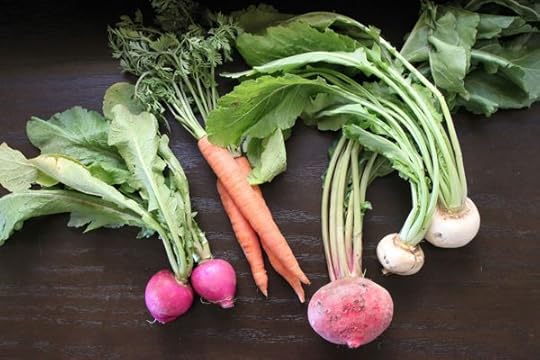
It can be easy to forget that the green tops of many vegetables are not only edible, but truly delicious. Beets, carrots, radishes and turnips often show up in supermarkets with no greens attached at all, and that’s a shame. When cooked and served with their greens, these veggies become side dishes with an amazing array of earthy, sweet, pleasantly bitter and peppery flavors.
Beet greens are probably the most familiar within this bunch. Turnip greens are a little more delicate but have a similar flavor. Radish greens are milder than the radish itself but still a bit peppery. Carrot tops are slightly pungent and herbal. All of these greens can be cooked in a variety of ways: sautéed or stir-fried with oil or animal fat (bacon is always delicious with greens), thrown into soups, chopped up raw and served in salads or thrown into smoothies.
The easy recipes below are eye-opening examples of how delicious veggie greens really are. After a few bites you’ll never have the urge to chop off the tops and throw them out again. You’ll also feel cheated when you can’t find the vegetables with their greens attached at the grocery store.
Next time you’re at the farmers market (where all vegetables keep their green tops) talk to vendors about their favorite edible veggie tops and how they like to prepare them. A whole new world of dark leafy greens will open up.
Recipe Tip: The stems of greens are optional eating; they’re often too chewy and tough to be enjoyable. Either pull the leaves from the stems or just cut off the bottom portion of the stem where no leaves are attached. Try to buy organic and make sure to wash all vegetable greens really well. It usually takes a few rinses in cold water to remove all the dirt and grit.
Beets & Greens with Black Olives
Servings: 4
Time in the Kitchen: 15 minutes of active cooking plus 1 hour to roast beets
Ingredients:
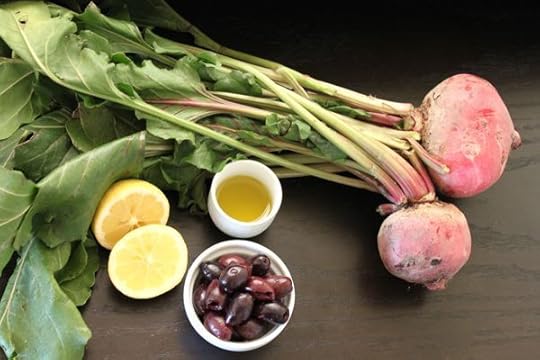
2 bunches of beets with greens
2 tablespoons olive oil (30 ml)
1 tablespoon lemon juice or orange juice (15 ml)
3/4 cup pitted kalamata olives or other pitted black olive (175 ml)
Instructions:
Preheat oven to 400 ºF (204 ºC).
Separate the beets from the greens.
Put the beets and 1/2 cup (125 ml) of water in a baking dish covered with a lid or tight foil. Roast in the oven until you can easily pierce the beets with a fork. The exact time will depend on the size of the beets but is likely to be between 30 to 60 minutes.
When the beets come out of the oven, set aside to cool. Once cool, rub off the skins. Slice the beets into small cubes.
Heat a large pot of water. When it comes to a boil add the beet greens and cook for just two minutes. Drain.
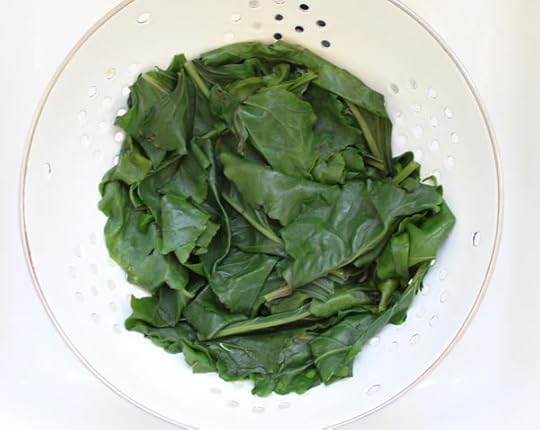
Let the leaves cool then use your hands to gently squeeze out excess moisture. Coarsely chop the greens.
In a food processor or blender, combine the olive oil, citrus juice and olives. Process until the olives are finely chopped.
In a large bowl gently toss the greens and beets with the olive puree.
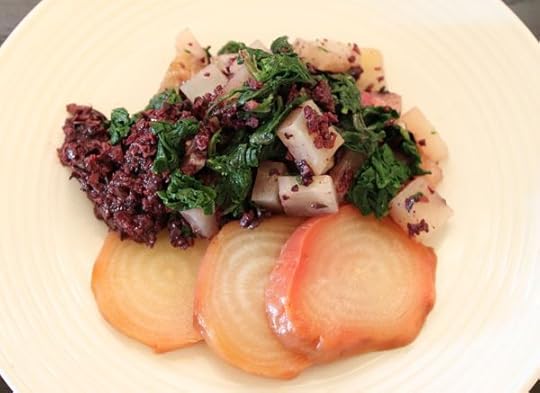
Turnips & Greens with Toasted Nori Salt
Servings: 4
Time in the Kitchen: 20 minutes
Ingredients:

1 sheet of nori
1/4 teaspoon sea salt (1 ml)
2 to 4 bunches of turnips with greens (eight to twelve turnips)
2 tablespoons of olive oil or sesame oil, or one tablespoon of each (30 ml)
Instructions:
To toast the nori, hold the nori sheet with tongs and wave it over a small open flame (such as a gas stove set on low). Don’t get the nori too close to the flame or hold it over the flame too long; it will quickly burn or possibly catch on fire. The idea is to just toast the nori so it becomes crispy. This will happen with just a few passes over the flame.
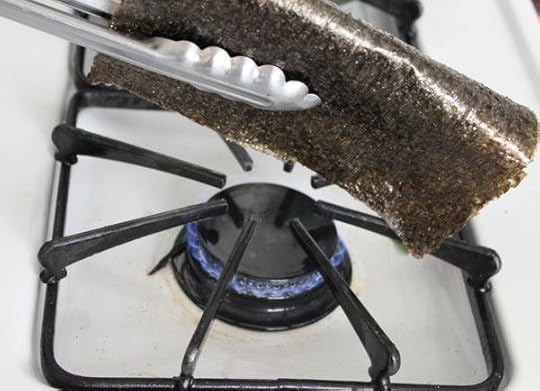
Crumble the toasted nori sheet into a coffee maker. Blend until it becomes a fine powder. Dump the nori powder into a bowl and mix it with the sea salt.
Separate the greens from the turnips. Trim off the ends of the turnips and slice the turnips very thinly. Whether or not you peel the turnips depends on how thick or marked up the skin is.
Slice the washed turnip leaves into thin strips and set aside.
Heat the oil in a wide skillet. When the oil is hot, add the turnips and saute 3 to 5 minutes until lightly browned.

Add the greens and sauté a few minutes more, just until the leaves are wilted.
Transfer the turnips and greens to a serving bowl and lightly sprinkle some of the nori salt on top. Keep leftover nori salt in a sealed container for future use.
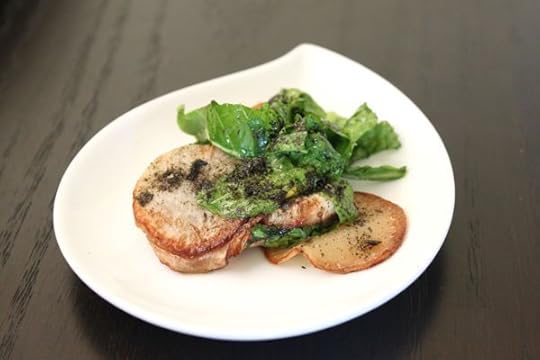
Sautéed Radishes and Greens
Servings: 4
Time in the Kitchen: 20 minutes
Ingredients:
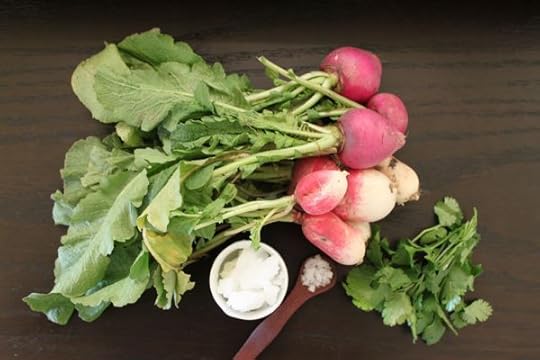
2 bunches of radishes with greens
2 tablespoons coconut oil (30 ml)
1/4 cup coarsely chopped cilantro (60 ml)
Sea salt and freshly ground pepper
Instructions:
Remove the greens from the radishes. Coarsely chop the washed greens and set aside.
Slice the radishes into thin rounds.
Heat the coconut oil in a wide skillet over medium-high heat.
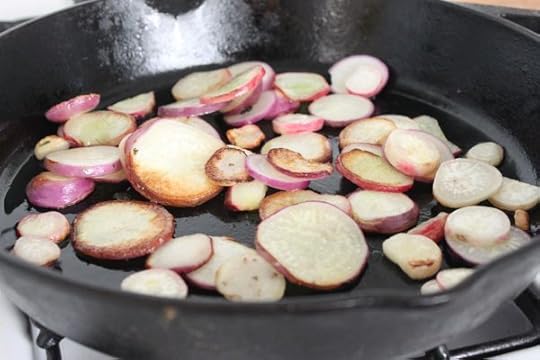
When the oil is hot, add the radishes and cook for 3 minutes without stirring. To brown properly, the radishes should be spread out in a single layer.
Stir the radishes and saute another 3 minutes.
Add the leaves and cook until wilted, 1 to 2 minutes.
Garnish with cilantro and salt and pepper to taste.
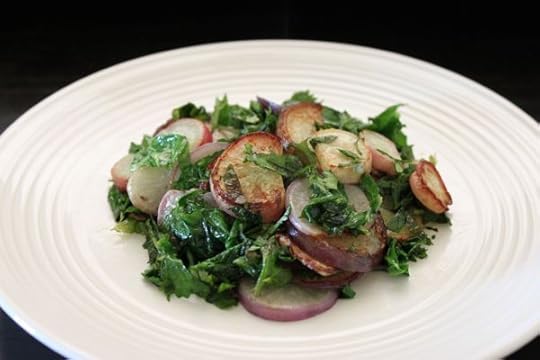
Carrot Top & Brazil Nut Pesto
This recipe was inspired by a carrot top pesto recipe in the cookbook Roots by Diane Morgan.
Servings: 4
Time in the Kitchen: 10 minutes
Ingredients:

4 to 6 Brazil nuts
1 clove garlic
1/8 teaspoon salt (0.5 ml)
2 tablespoons grated Parmigiano-Reggiano cheese (30 ml)
1 1/2 cups loosely packed carrot top leaves (375 ml)
1/3 cup extra virgin olive oil (75 ml)
Instructions:
In a food processor combine the nuts, garlic, salt and cheese until very finely chopped.
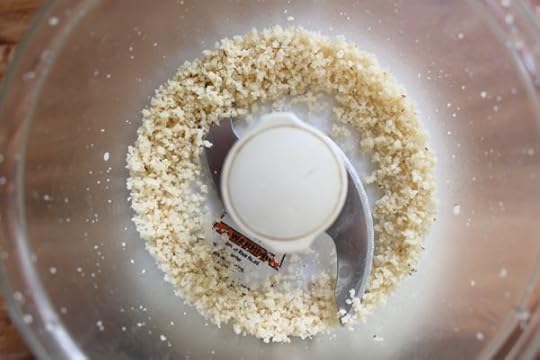
Add the carrot tops and oil then pulse just until the ingredients are combined.
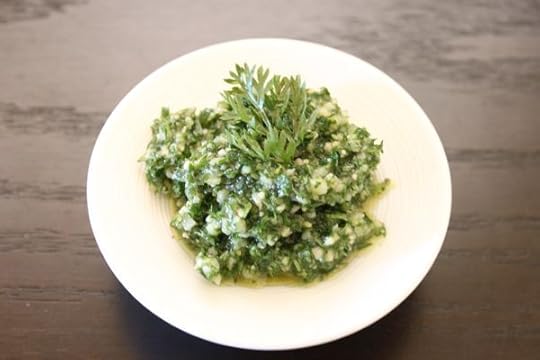
Get All Three Primal Cookbooks, an Apron and More in The Primal Blueprint Chef Kit Today!

January 11, 2013
I Feel Like I Finally Have Control Over My Life
It’s Friday, everyone! And that means another Primal Blueprint Real Life Story from a Mark’s Daily Apple reader. If you have your own success story and would like to share it with me and the Mark’s Daily Apple community please contact me here. I’ll continue to publish these each Friday as long as they keep coming in. Thank you for reading!
Side Note: If you bought a copy of The Primal Connection this week, take a few moments and leave a review on Amazon so we can push this baby high up the ranks. Thank you!
 Mark,
Mark,
I want to thank you for changing my life. I reached my peak weight of 292 pounds in 2011 at 23 years old. I had everything going for me, but I still wasn’t happy because I felt so trapped in my body. I was recently married to the love of my life, I was managing my family’s Middle Eastern restaurant, and about to graduate college after six years of schooling. Even though my life was going so great, I was horribly depressed.
My life has always revolved around food. My dad is Lebanese, and owns a Lebanese restaurant which I feel like I’ve been working at since I could barely walk. I learned that celebrations always included food, and when I was feeling down or things weren’t going my way that food was always there for me. I was always a heavy kid, but I didn’t really start to blow up until high school. I hated high school as many people do because I felt like I didn’t fit in, didn’t have many friends, etc. When I turned 16 I got a car, and I had money from working at my family’s restaurant, so the daily trips to Wendy’s started. I got two spicy chicken sandwiches and french fries almost every day after school, then went home for a big dinner with my family. Before I even realized what was happening I was pushing 300 pounds for the first time in my life.
I stayed that big until the first year of college. I thought I wanted to get away from my family so I chose a college that was in the mountains, about three hours away. I ended up losing about 60 pounds that year because I didn’t have a car, and had to walk everywhere. My dorm was on the top of a very large hill, and the cafeteria at the bottom. When it’s 0 degrees outside and there are about 300 steps between you and food, many times you chose to just go hungry, or at least I did. After one year at that college I decided to come back home. I started working at the restaurant again, moved in with some friends and truly was relying completely on myself for the first time in my life. For the next year I tried doing the Atkins diet off an on. Which really looked like carb restricting for two weeks, then carb binging for two weeks. When I was carb restricting and trying to limit myself to 20 g of carbs a day, I was only living on meat and cheese and I felt so gross. Then when I was carb binging, I felt even worse. Somehow I managed to lose another 20 pounds like that though over the course of a year, leaving me at the lowest weight of 210 that I had been in years.

Then I met my future husband. Instantly we knew that we wanted to be together, get married and go the whole nine yards. I felt like I was in La La Land for the first six months and completely forgot about the dieting. I feel like we ate out every night, he brought me chocolate all the time, basically celebrated the new found relationship with food. For him, it was nothing because he has always been naturally skinny and able to eat whatever he wanted without gaining any weight. But for me it was another story. I gained the 80 pounds I had lost and then some within a matter of months. I stayed around 300 pounds through our engagement and wedding and for the next couple months afterwards. Then I had a wake up call. I saw some pictures of me from my husband’s birthday party and knew I had to get serious. One of my friends had mentioned MyFitnessPal.com on Facebook and I decided to check it out. I liked it and with my sedentary office job I was able to be on the computer and track all my food no problem. I joined there on 8/5/11 at 292 pounds. After 4 months on MFP and strictly calorie counting without a change in diet, I had lost about 30 pounds. But my dedication was wavering and my weight loss slowing down very quickly. On the forums on MFP I saw alot of people mentioning the Primal/paleo diet and luckily for me, one of them posted a link to Mark’s Daily Apple. I was hooked. I spent hours reading through all the material on the website, looking up different recipes, downloading the free ebooks, etc. This was the first “diet” that ever made sense to me! It was like my big AH HAH! moment. I asked for your book The Primal Blueprint for Christmas, and devoured it within a couple of days. From there on I was Primal. The first couple weeks were the hardest, because my body was shifting from being a sugar burner to a fat burner, and I was trying to adjust my eating habits and figuring out new favorite foods. But after that I feel like this has been so easy and effortless. The weight has literally melted off, without killing myself in the gym, without starving myself, without feeling sick. In one year I’ve lost 94 pounds to be at my current weight of 168. I didn’t exercise, but did have a change in activity level, with my dad opening a new store and me being promoted to the general manager rather than the office manager. I work about 55-60 hours a week now with most of it being on my feet, walking around the store, lifting boxes, bus tubs, etc. I didn’t start actually working out until about a month ago when I decided I wanted to start toning and lifting weights.


Now, I feel like I’m a completely different person, I’m so happy and I don’t feel trapped in my body anymore. I feel like nothing is holding me back anymore. I feel so powerful because I can run, jump, lift, stretch without becoming out of breath or needing to take a break. I have so much energy! I don’t have to obsess over what I’m eating, I just eat along the Primal guidelines and know that I’m feeding my body nutritious food that it craves. Food has become fuel (delicious fuel!!) but it is no longer my comfort, my shoulder to cry on, my means to celebrate, or my dirty secret. I literally do not remember ever being this weight, although logically I know I must have been at some point. When I went from kids clothes to the adult department I immediately went into a size 12, and then a few months later I had to start shopping at the plus size store. Now I’m a size 8 pants, and a medium top….and I can shop ANYWHERE! For the first time in my life, I can shop in any store. I ran a mile for the first time in my life this month too! As far as my relationship with my husband, we are better than ever. My new found confidence has improved the relationship, and I feel like he doesn’t have to worry about me anymore. He knows that I’m healthy and gonna be around for a long time with him. And that he gets to enjoy my happiness, rather than try to pull me out of depression.
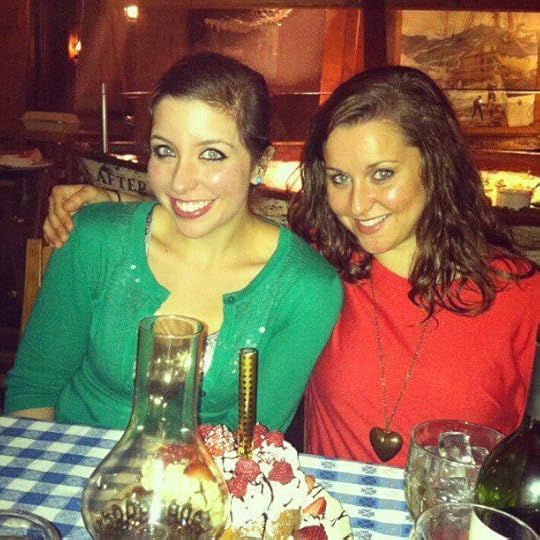

Now my plans are to eat Primal for the rest of my life, lose eight more pounds to get to my goal of 160 and to continue toning and lifting weights to maximize my body’s potential. I am so excited about the future and I feel like I finally have control over my life. I can’t wait to update you in a year after weight training to show you where my body is at then!
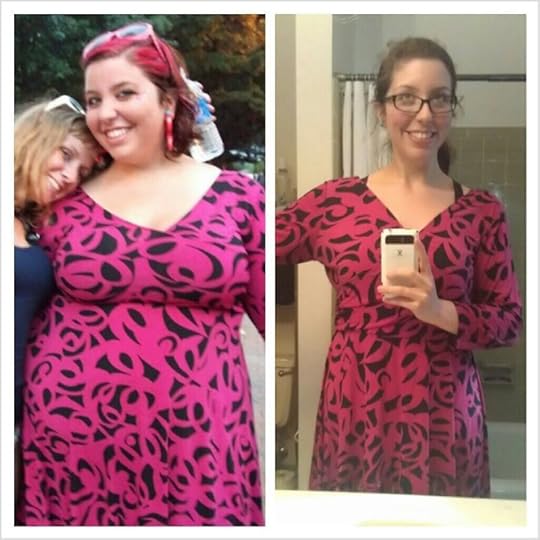

Fairuz
Grab a Copy of The Primal Connection and Take Control of Your Life Today!

January 10, 2013
The Primal Connection Bonus Offer Extended Through Sunday
 Thanks to your tremendous support, The Primal Connection has risen to the top of many book rankings on Amazon.com and elsewhere. It’s reached #1 in the Healthy Living category, #1 in Personal Health, #1 in Personal Transformation, #1 in Self-Help, and #10 out of all books sold on Amazon! (At the time of this writing it is at #13 overall.)
Thanks to your tremendous support, The Primal Connection has risen to the top of many book rankings on Amazon.com and elsewhere. It’s reached #1 in the Healthy Living category, #1 in Personal Health, #1 in Personal Transformation, #1 in Self-Help, and #10 out of all books sold on Amazon! (At the time of this writing it is at #13 overall.)
Once again I’m completely floored by the power and generosity of this community. It goes to show that you always get back more than you give. The Primal Connection was a three year labor of love, and it was worth all the effort to see the response, to read the reviews, and to see it already touching people’s lives.
Here are some screenshots of what you have done for The Primal Connection:
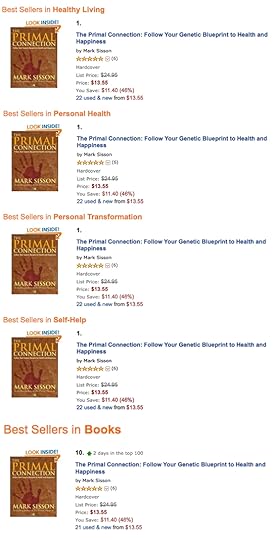
I probably don’t have to tell you that topping these charts helps get the Primal/paleo movement the mainstream exposure and attention it needs to effect real change. Motivated by what I’ve seen I’ve decided to extend the special bonus offer through Sunday, Jan. 13, 11:59 pm PST. You also now have until Monday, Jan. 14, 11:59 pm PST to submit your receipt. See all the details here.
There are a couple practical reasons I’ve decided to extend the offer as well. Books shipped from Amazon.com were delayed by a couple days meaning people didn’t get the book quickly enough to have a chance to review it and then recommend it to friends or buy gifts for family while the offer still lasted. Also, we haven’t yet reached the 2,000 limit for the 3 book offer, so there are gift certificates remaining to be given away. There’s no use in me holding on to Tendergrass Farms gift certificates. They’re better off in your hands. And hey, selling a few more books helps keep Mark’s Daily Apple going strong, too.
If you’ve already bought a book, thank you so much! Upon completing the online receipt submission form we will send you your bonuses ASAP. This extended offer won’t affect you in any way.
To those that haven’t picked up a copy yet, what are you waiting for?! This is your final chance to take advantage of the special bonus offer. Order your copy today and claim your free gifts while the offer lasts. Many thanks again and Grok on!
Get Your Copy of The Primal Connection Today!

Mark Sisson's Blog
- Mark Sisson's profile
- 199 followers



